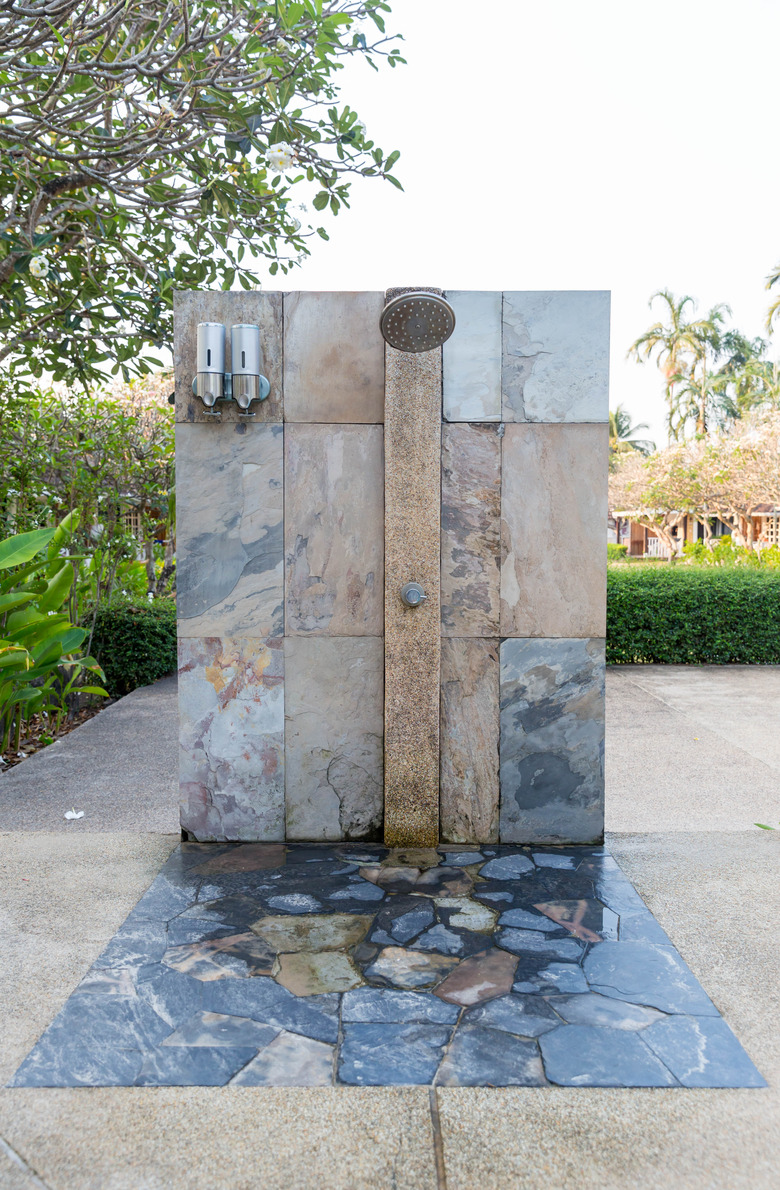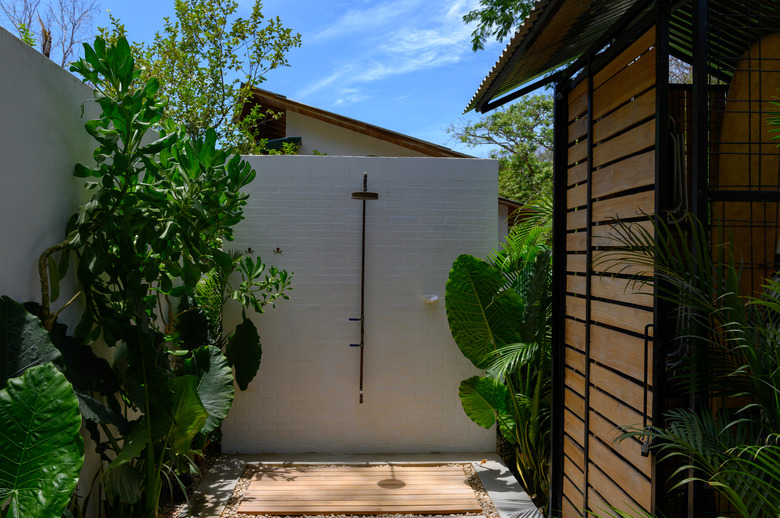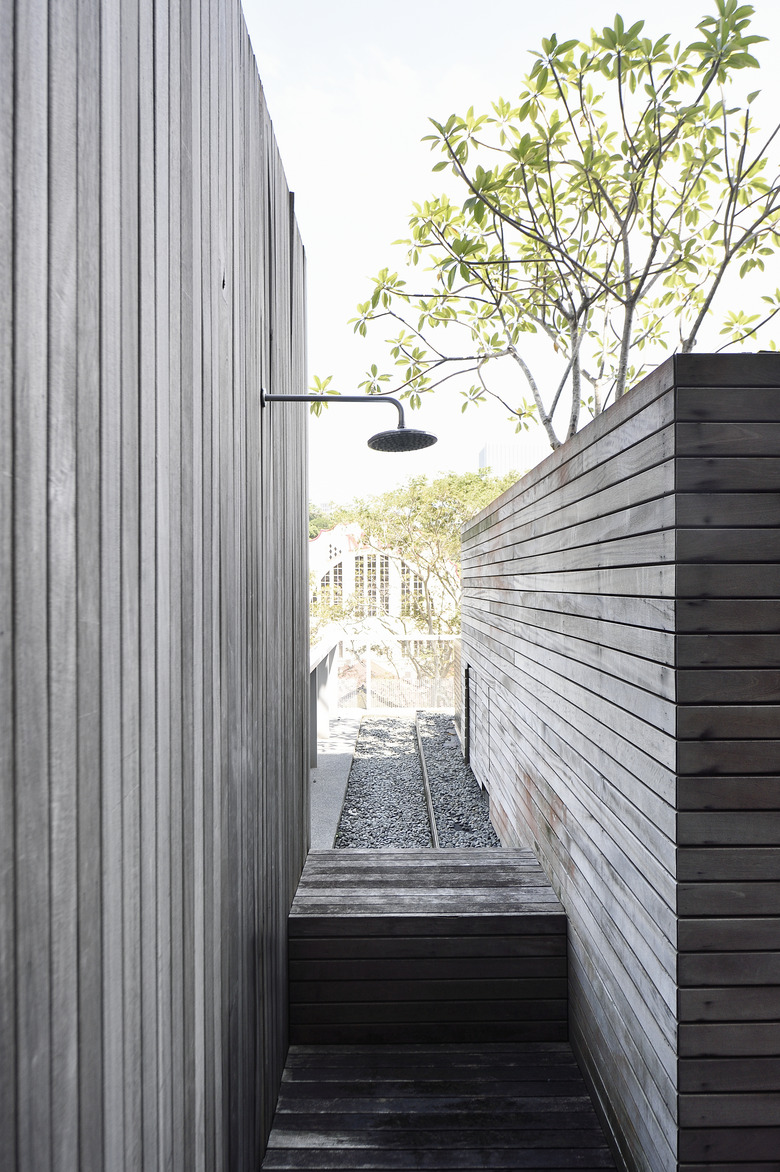Essential Parts Of An Outdoor Shower
We may receive a commission on purchases made from links.
You don't need to live in a warm climate to appreciate a brand-new outdoor shower because even if you have freezing winters, you'll have plenty of opportunities to use it in the sweltering summer months. If you've never thought about installing one before but are now getting the hankering, you're probably wondering what's involved and how much it's going to cost. The answer depends on how elaborate you want to make it, and that in turn depends on how you want to use it.
Some people install an exterior shower to supplement their indoor one, and they design it to give more or less the same shower experience. Others put one out in the garden to get a quick cool-off when working in the hot sun, and still others put one by the pool with a sign requesting that pool users shower before entering the pool. A simple garden shower or one by the pool doesn't need many shower parts. It needs to have only a basic showerhead to produce a refreshing, cleansing stream of water, and if hot water isn't needed, it just needs an on/off control. If there is hot water, plumbing regulations require a mixing valve with anti-scald protection.
Apart from the water delivery system, an outdoor shower needs a solid base on which you can stand, and if you plan to use it without a bathing suit, it needs a privacy screen. When designing the shower, you may also have to plan a way to deal with the wastewater. Depending on local health codes, you may be able to let water from a garden shower flow into the garden, but if the shower is close to the house, you'll probably need some type of drainage system. You need to keep water away from the foundation and prevent it from pooling on the patio or dripping through the deck slats and creating a soap-laden mess on the ground underneath.
A Simple Freestanding Garden Shower
A Simple Freestanding Garden Shower
A freestanding garden shower is a DIY dream because all you need is a store-bought shower fixture, a garden hose and a private place to shower. If you can't locate the shower on a concrete patio or some other similarly solid surface, you might have to build a shower base, although some freestanding showers come with a premade platform. Options for a DIY platform include a tiny patio made with concrete pavers or a freestanding deck built with redwood, cedar, teak or a similar species of rot-resistant wood. One thing to remember is that wood shower platforms get slippery after repeated showers, so if you build a deck, you might want to consider finishing it with a nonslip coating.
Both pavers and decking boards allow water to pass through and seep into the ground, and if you locate the shower on well-draining soil, no other drainage may be necessary. A good way to test the soil is to pour a 5-gallon bucket of water on it and time how long the water takes to seep in. If it takes longer than five minutes, you should route the shower runoff to another part of the yard with a French drain or construct a dry well under the shower. Communities that forbid allowing gray water to seep into the soil to prevent soap from contaminating groundwater may allow you to route a French drain to a suitable catchment or drainage area.
If you're happy with a cold-water shower, you can choose a freestanding shower that comes complete with a showerhead and flow controller that connects to your garden hose. You may prefer a hot shower, in which case you might choose a solar shower with a black plastic reservoir that holds 5 or more gallons of solar-heated water. Solar showers also come with adapters for garden hoses, but beware — the water in the reservoir gets hot enough to scald you, so make sure you adjust the temperature with the provided mixing valve and test the water before using the shower.
A More Complete Outdoor Shower Experience
A More Complete Outdoor Shower Experience
If you want an outdoor shower that more closely duplicates the showering experience of an indoor one, you need to add a privacy screen and a source of hot water that doesn't depend on the sun. An easy way to provide privacy is to purchase a freestanding shower stall, which comes complete with a mixing valve with hot- and cold-water inlets, a showerhead, a curtain and even a grab bar for safety. This type of unit doesn't connect to a garden hose, so before setting it on a level area in the yard or near the house, you have to install water supply pipes and devise a drainage system.
One of the problems with low-end shower stalls is that the showerhead and valve trim are often made of chrome plated brass, which doesn't last long outdoors. Stainless steel may be more expensive, but it's is more durable, and if you want the shower to last, you're better off purchasing a stainless steel wall-mounted outdoor unit; attaching it to the side of your house, an outbuilding or a fence; and constructing your own platform and privacy partition. Going this route gives you the opportunity to DIY the shower to make it a more attractive addition to your landscape.
You can construct a full-height stall around the shower and provide a hinged shower door, or you can enclose the shower with a curtain using a curved curtain rod. You can also erect a partial screen from bamboo or reed fencing that provides whatever privacy isn't created by nearby shrubs and bushes. The screen should allow air to circulate inside the shower, or mold will quickly become a problem. If you build a screen from a porous material, such as wood, apply a waterproofing seal coat to make cleaning and maintenance easier.
The Ultimate Outdoor Shower Package
The Ultimate Outdoor Shower Package
If you have the budget for it, you may want to pull out all the stops and build an outdoor shower that's every bit as luxurious and functional as the one in your main bathroom. This type of shower needs both hot- and cold-water supply pipes, and to avoid having them burst in the winter, they should be installed in an exterior wall and insulated. This limits the placement of the shower to locations adjacent to the house or an outbuilding that already has plumbing, but because the supply pipes are connected to the building's water supply, you don't have to worry about how to get hot water.
The outside of the stall can be constructed with the same materials as the house, and the inside can be tiled. You can install a thermostatic shower valve that allows you to preset the temperature so you don't have to fiddle with the temperature setting when it's cold outside, and for a luxurious touch, you might consider a rainfall showerhead with a hand shower attachment. Remember that all metal parts in the shower should be stainless steel or a similar corrosion-resistant metal if you want them to last, including the shower faucet, the shower arm and the showerhead as well as any shelving and grab bars you install.
Plumbing an Outdoor Shower
Plumbing an Outdoor Shower
Supplying water to a freestanding or wall-mount shower with a hose adapter is as easy as hooking up a garden hose to the nearest outdoor faucet, but if you choose a shower with inlets for hot and cold water, you need a hot-water source. The easiest solution, assuming you don't build the shower on the side of the house and tie it into the existing plumbing, is to locate the shower close to a hose bib, install a hot-water bib next to it and connect that to a hot-water supply pipe in the house. The safest way to connect the shower to the hose bibs is to use braided steel tubing, which is easy to remove in the winter to prevent freezing.
If you prefer to locate your shower in the yard, you can supply hot water with an on-demand water heater. You can purchase an electric one, but the most practical ones run on propane, which means you need to keep a 5-gallon propane tank nearby. Some supply hot water to the shower mixing valve, while others mix the hot and cold water, eliminating the need for a mixing valve in the shower. If you don't purchase an on-demand heater designed for outdoor use, you'll have to build a properly vented enclosure for it.
The sophistication of the drainage system for your outdoor shower depends on where you locate it and the applicable local regulations concerning gray water disposal. If you build a high-end shower located on a patio next to the house, you'll probably have to install an underground drain pipe and connect it to the home's waste system. In this case, you'll need all the drain components you'd need for a conventional shower drain, including a 1 1/2-inch plastic P-trap, a vent pipe and a 2-inch waste pipe.
Additional Shower Accessories
Additional Shower Accessories
No shower, whether it's indoors or outdoors, is complete without a place to hang towels. Unless you plan to hang them on nearby tree branches, which is an option, you'll want to screw towel hooks to a nearby fence or post or to the sides of the shower stall itself. A fun way to make them is to use 1/2-inch galvanized pipe nipples. Screw a 2-inch nipple into either end of a 90-degree elbow, cap one end and screw the other end into a flange screwed to the wall. If you don't want to DIY these, it's no problem — you can buy them. Considering that shower platforms tend to be slippery when they are wet, you'll also want grab bars, and these can double as towel racks.
It's handy to have benches near the shower area to make it easier to get undressed, and while a few tree stumps can serve the purpose, there is no shortage of ready-made benches online. You can choose one made from bamboo, but if you want it to last, teak is a better option. Of course, there's nothing preventing you from making your own DIY shower bench from teak, redwood or cedar. If you build a shower stall from wood or tile, it's a good idea to build in a bench from the same materials, and it's easy to do. Just make sure it's from 17 to 19 inches high, which is the recommended height that makes it easy for everyone to use, and make sure it doesn't reduce the available shower space to less than a circular area with a 30-inch radius.


